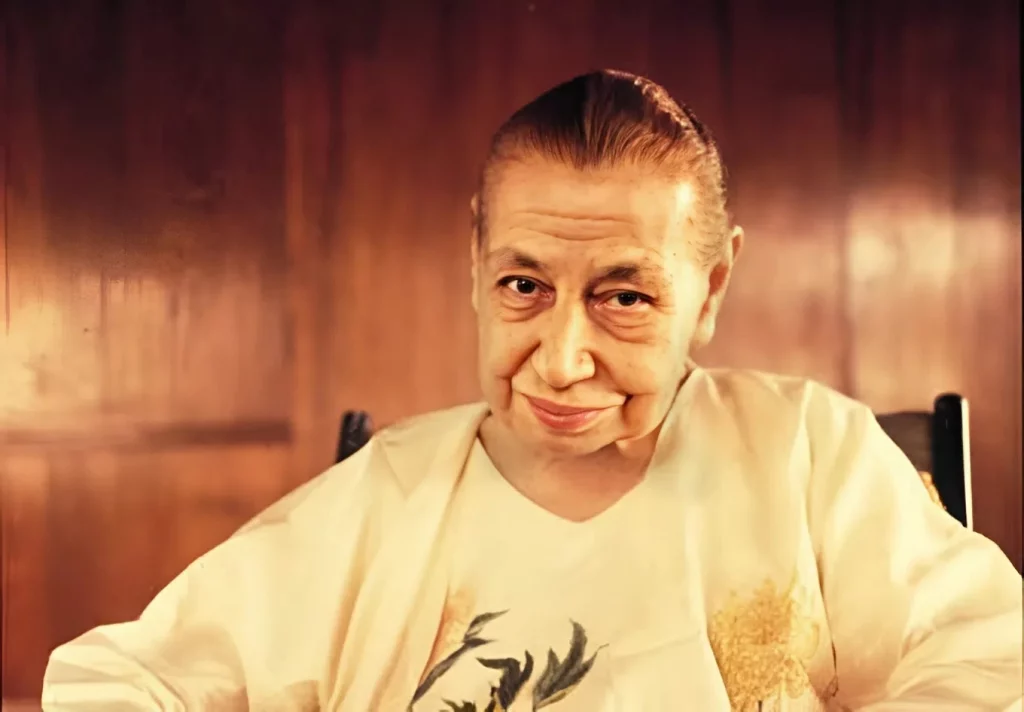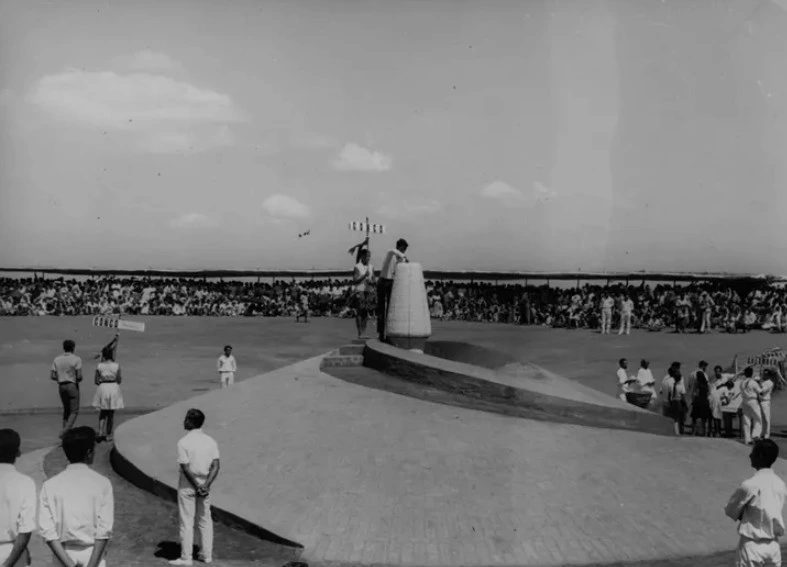(August 21, 2025) On a sunlit morning in February 1968, young men and women from 124 countries and 23 Indian states gathered on a barren plateau outside Puducherry. Each carried soil from their homeland, which they poured into a white marble urn set at the amphitheatre beneath a lone banyan tree. At that moment, fragments of earth from across the globe merged with Indian soil, and Auroville, the city of human unity was born. At its heart lay the extraordinary journey of a Paris-born mystic, Mirra Alfassa, who became The Mother. Her life, threaded between art, mysticism, and India’s spiritual destiny, made this daring dream possible.
Today, Auroville is a thriving international community of nearly 3,000 residents from 55 nations, located about 10 km north of Puducherry in Tamil Nadu. Spread across some 20 square kilometers of once-barren land, it is now a green oasis of forests, farms, sustainable enterprises, and the iconic golden Matrimandir at its heart. The township was named Auroville in honour of Sri Aurobindo (1872–1950), the philosopher, poet, and freedom fighter who became one of India’s foremost spiritual figures.

Childhood of visions
Born in Paris in 1878, Mirra grew up in a cultured, cosmopolitan household. Her father, of Turkish-Jewish descent, and her Egyptian-Jewish mother provided her with an upbringing steeped in books, music, and philosophy. By fourteen, she had devoured much of her father’s library.
Yet alongside intellectual pursuits came mystical awakenings. Between the ages of eleven and thirteen, she experienced vivid spiritual states that convinced her of humanity’s latent potential for divine union. She often spoke of seeing a guiding presence, and in adolescence began having visions of a dark, radiant figure she later identified as Krishna.
Artist in Paris, seeker within
In her teens, Mirra trained at Paris’s Académie Julian, where she pursued painting seriously and exhibited at the Salon d’Automne. Outwardly, she appeared destined for a life among Europe’s artists and intellectuals.
But inwardly, her questions deepened. She turned to Swami Vivekananda’s Raja Yoga and the Bhagavad Gita, finding in them a resonance that Western philosophy could not provide. These texts gave form to her inner experiences and sowed the seeds of her attraction to India, the land where spirituality is not separate from life, rather is its essence.

Mirra Alfassa during her younger days in France
Meeting Sri Aurobindo
The decisive moment arrived in 1914, when Mirra travelled to Pondicherry with her then-husband, Paul Richard. The moment she met Sri Aurobindo, she recognized him as the being of her visions. She later wrote: “His presence is enough to prove that a day will come when darkness shall be transformed into light.”
World War I forced her to leave India soon after that first meeting, and she spent the next years in France and Japan. But the pull of India remained, and in 1920 she returned for good. Sri Aurobindo saw in her the embodiment of the Divine Shakti, and soon she was simply known as The Mother.
After playing a leading role in the nationalist movement, Sri Aurobindo turned inward to develop his vision of Integral Yoga which is an evolutionary path that seeks not escape from the world, but the transformation of human life into a divine life. It was this philosophy of human unity and spiritual evolution that The Mother later sought to translate into the living experiment of the Auroville township.
Shaping the Ashram
When Sri Aurobindo withdrew from public life in 1926, The Mother took charge of the Sri Aurobindo Ashram. She shaped its rhythms of meditation, education, and collective service. For her, spirituality was not renunciation but transformation. “Spirituality is not the renunciation of life; it is the divinization of life,” she said, her words deeply resonating with India’s civilizational ethos.

Mirra Alfassa and Sri Aurobindo
After Sri Aurobindo’s passing in 1950, Mirra Alfassa carried forward their vision. In 1952, she founded the Sri Aurobindo International Centre of Education, pioneering a system of learning that was free from examinations, and was rooted in freedom, creativity, and self-discovery.
Dreaming Auroville
Her most daring vision, however, went beyond the ashram walls. Since the 1930s, The Mother envisioned a universal township where people of all nations could live beyond religion, politics, and personal ownership. By the 1960s, the dream crystallized as Auroville—its name meaning City of Dawn in French (aurore ville), and also honouring Sri Aurobindo as its guiding inspiration.
“There must be somewhere on earth a place no nation can claim as its own,” she said. “Where all human beings of goodwill can live freely as citizens of the world.” The Government of India, under Prime Minister Indira Gandhi, offered its backing, recognizing in Auroville not just a utopian dream but a national commitment to India’s role as a spiritual host for the world.

Former PM Indira Gandhi with Mirra Alfassa at Auroville
Laying Auroville’s foundation stone
On February 28, 1968, under a lone banyan tree near Puducherry, 5,000 people witnessed Auroville’s inauguration. Youth representatives from across the world and India poured soil from their homelands into a marble urn, symbolizing the unity of humanity.
From her room in Puducherry, The Mother’s voice was broadcast reading the Charter of Auroville: “Auroville belongs to nobody in particular. Auroville belongs to humanity as a whole.” The words were repeated in sixteen languages, carried like a promise across the winds of India.
India embraced the vision wholeheartedly. Prime Minister Indira Gandhi hailed it as “an exciting project for bringing about harmony among different cultures and for understanding the environmental needs of man’s spiritual growth.” UNESCO too gave its rare endorsement, passing resolutions in 1966 and thereafter commending Auroville as a project of “international importance for the future of humanity.”
In the years that followed, as challenges emerged, the Government of India intervened through the Emergency Provisions Act of 1980. This was followed in 1988 by the Auroville Foundation Act, which vested Auroville’s assets in a statutory foundation and set up a structured framework of governance, ensuring the township could flourish as a model of spiritual aspiration and international collaboration.

Foundation stone laying ceremony of Auroville in 1968
Towards a soulful economy
For The Mother, Auroville was never to be a retreat. It was to be a living city sustained by conscious work. She designated one zone Auroshilpam—“industry with a soul.” “Money is not meant to make money,” she declared. “Money is meant to make the earth ready for the Supramental manifestation.”
Today, Auroville houses over 230 enterprises in fields like eco-architecture, organic farming, textiles, and renewable energy. Nearly 5,000 people from nearby villages work in these ventures, proving how global ideals can empower local communities. At its heart stands the Matrimandir, a golden sphere of meditation, which is not just a temple, but a collective aspiration in silence.
Consciousness beyond mind
The Mother’s deepest work lay in consciousness itself. With Sri Aurobindo, she had articulated the concept of the Supramental consciousness—a force beyond mind that could harmonize spirit and matter.

Matrimandir, a prominent structure and spiritual center located in the heart of Auroville
From 1956 until her passing in 1973, she chronicled her inner experiments in The Mother’s Agenda, a 13-volume diary of struggles and breakthroughs. “Evolution continues, and man will be surpassed,” she wrote. Auroville, in her vision, was not just a township but a preparation for humanity’s next evolutionary leap.
Legacy in India’s keeping
In 1973, at the age of 95, The Mother passed away in Puducherry. She was laid to rest beside Sri Aurobindo at the Ashram Samadhi, under a tree where seekers still bow in silence. Her work endures.
Visitors pause beneath the spreading banyan tree and before the urn of world soil, which are the symbols of that first morning in 1968. They remind the visitors that Auroville is not only The Mother’s dream, but also a promise placed in India’s keeping: the promise of human unity.
In a world fractured by division and ecological crisis, her words feel urgent: “For those who are satisfied with the world as it is, Auroville obviously has no reason to exist. But for those who still believe humanity can evolve, Auroville will always be there.”

Auroville at a Glance
- Brought to life by 124 nations: Soil from 124 countries and 23 Indian states placed in a unity urn in 1968.
- Backed by UNESCO: Endorsed by UNESCO since 1966.
- Multinational residents: Close to 3,000 people from 55+ countries live here today.
- Beyond religion and politics: Built on consciousness, not creed or nationality.
- Sustainable economy: 230+ enterprises employ 5,000 locals from Tamil Nadu.
- Indian roots, global vision: Inspired by Sri Aurobindo, led by a Paris-born mystic who became The Mother.



